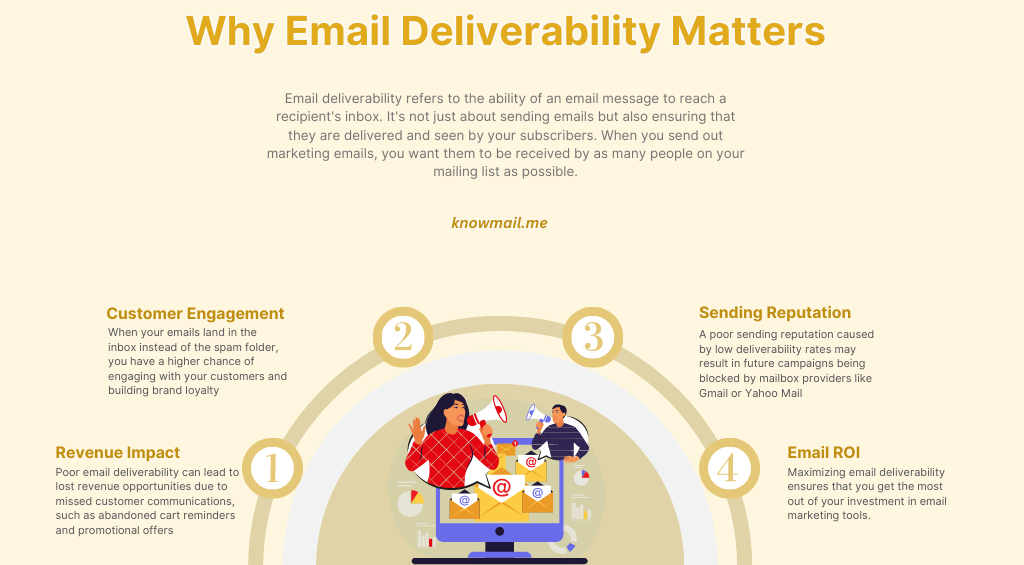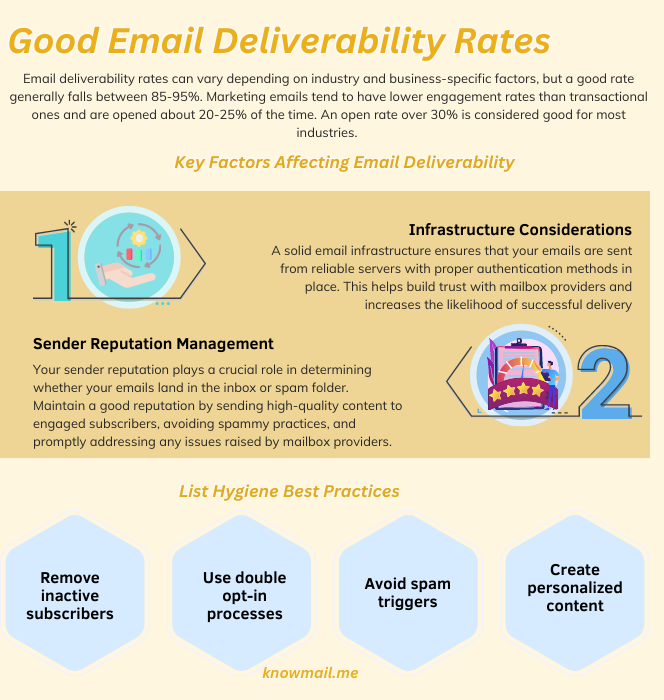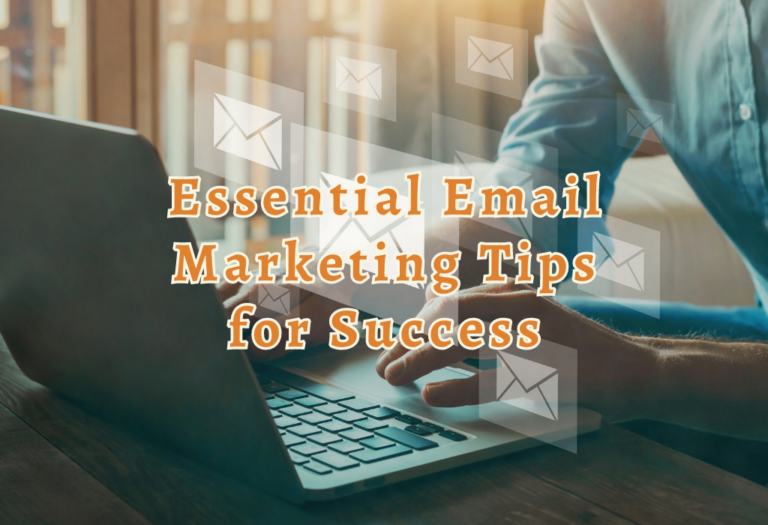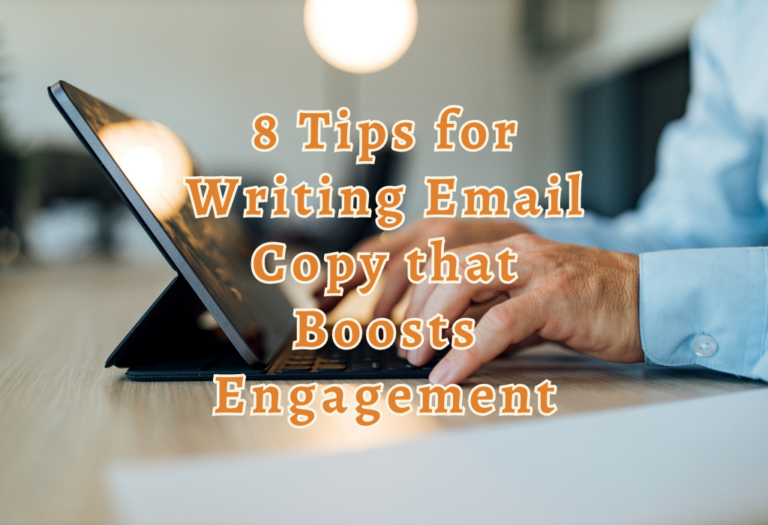Email deliverability matters more than ever in today’s digital marketing landscape. As an essential component of successful email campaigns, it can significantly impact your ability to reach and engage with your target audience.
In this guide, we’ll examine the components of successful email deliverability and provide actionable steps to enhance your campaigns.

More Resources :
What is Email Deliverability?
Email deliverability refers to the ability of an email message to reach a recipient’s inbox. It’s not just about sending emails but also ensuring that they are delivered and seen by your subscribers. When you send out marketing emails, you want them to be received by as many people on your mailing list as possible.
The Importance of Email Deliverability
Email deliverability is a critical aspect of digital marketing, as it determines the ability of marketing or transaction emails to reach recipients’ inboxes without being bounced or marked as spam. According to research, only 79.6% of legitimate emails actually reach their destination, emphasizing the need for businesses and marketers to improve their email deliverability rates.
Why Email Deliverability Matters

Understanding Good Email Deliverability Rates
Email deliverability rates can vary depending on industry and business-specific factors, but a good rate generally falls between 85-95%. Marketing emails tend to have lower engagement rates than transactional ones and are opened about 20-25% of the time. An open rate over 30% is considered good for most industries.
Industry Benchmarks for Email Deliverability Rates
Different industries experience varying levels of email deliverability success due to their target audience’s preferences, content types, and sending frequencies. For instance, ecommerce businesses might see higher open rates because customers expect order confirmations or shipping updates in their inbox. On the other hand, B2B companies may struggle with lower open rates if they send too many promotional messages without providing valuable information or insights.
Factors Influencing Engagement Rates

Key Factors Affecting Email Deliverability
Email deliverability is influenced by several factors that are under a business’s control. Addressing these aspects can improve your chances of reaching recipients’ inboxes and achieving better engagement rates.
Infrastructure Considerations
A solid email infrastructure ensures that your emails are sent from reliable servers with proper authentication methods in place. This helps build trust with mailbox providers and increases the likelihood of successful delivery.
Sender Reputation Management
Your sender reputation plays a crucial role in determining whether your emails land in the inbox or spam folder. Maintain a good reputation by sending high-quality content to engaged subscribers, avoiding spammy practices, and promptly addressing any issues raised by mailbox providers.
List Hygiene Best Practices
How Can You Improve Your Email Deliverability?
If you’re experiencing issues with email deliverability, there are steps you can take to improve it:
- Beware of Spam Traps: Avoid using purchased lists or collecting addresses through web scraping tools which may contain spam traps – fake addresses used by ISPs and anti-spam organizations in order identify spammers who add any address they find without permission.
- Clean up Your Mailing List: You should regularly remove inactive subscribers from your mailing list; this will help keep high levels of user engagement while minimizing bounce rates due to non-existent mailboxes. Here’s how to clean your email list.
- Improve Your Sender Reputation: ISPs use sender reputation as a way of determining whether or not an email is spam. A good sender reputation can help ensure that your emails are delivered to the recipient’s inbox instead of being sent straight to their spam folder. Learn more about improving your sender reputation here.
Authentication Standards for Better Delivery Results
Email authentication is a crucial aspect of maintaining good email deliverability. Implementing proper authentication standards such as SPF, DKIM, and DMARC can help ensure mailbox providers do not flag your emails as spam or rejection.
Implementing SPF Authentication
Sender Policy Framework (SPF) is an email validation system designed to prevent spoofing by verifying that the sender’s IP address matches the authorized sending domain. To implement SPF, you need to create a DNS TXT record in your domain’s DNS settings containing information about which mail servers are allowed to send emails on behalf of your domain. This helps mailbox providers determine if an incoming email claiming to be from your domain is legitimate or not.
Utilizing DKIM Signatures
DomainKeys Identified Mail (DKIM) adds an encrypted signature to outgoing emails that can be verified by receiving mail servers using public key cryptography stored in a DNS record associated with the sender’s domain name. Implementing DKIM signatures adds another layer of security against phishing attacks and other fraudulent activities while improving overall deliverability rates.
Setting up DMARC Policies
Domain-based Message Authentication Reporting & Conformance (DMARC) builds upon both SPF and DKIM protocols, allowing senders greater control over their messages’ handling when they fail either one or both checks at recipient domains. It also provides valuable feedback about your email delivery performance. To set up DMARC, you need to create a DNS TXT record containing information on how mailbox providers should handle emails that fail SPF and/or DKIM checks (e.g., quarantine or reject) as well as where to send aggregate reports of authentication results.
Clean Coding Practices & Subscriber Acquisition Methods
Email code is another factor affecting delivery; clean coding without any potentially malicious codes or URLs linking to websites with poor reputations helps avoid triggering spam filters. Furthermore, businesses need to follow proper subscriber acquisition practices and not send emails containing bad addresses like hard bounces or spam traps since these can hurt overall performance if they exceed 2%.
Tips for Clean Email Coding
To ensure your email code doesn’t trigger spam filters, follow these best practices:
Avoiding Bad Addresses and Spam Traps
Maintaining a high-quality subscriber list is crucial for good deliverability rates. Here are some tips to avoid bad addresses and spam traps:
Monitoring Spam Complaints & List Quality
Email deliverability matters and can be significantly impacted by email deliverability issues such as spam complaints from email users who mark an email as spam. These complaints demonstrate poor engagement rates and may lead to mailbox providers blocking future email campaigns from reaching their recipient inboxes. Therefore, improving email deliverability starts with maintaining high-quality email lists through regular checks against services like Email List Verify, NeverBounce, Data Validation, or ZeroBounce.
Reducing Spam Complaints
Tools for List Quality Maintenance
Maintaining a clean email list is essential for improving email deliverability and reducing bounce rates. Here are some popular tools that help you verify the quality of your email list:
- Email List Verify: This tool helps you remove invalid, inactive, and duplicate email addresses from your email list.
- NeverBounce: With real-time verification and a comprehensive dashboard, NeverBounce ensures that your email list is clean and up-to-date.
- Data Validation: This service provides an easy-to-use platform for verifying the accuracy of your email recipient data.
- ZeroBounce: In addition to validating emails, ZeroBounce offers features like abuse detection and spam trap removal to improve overall email deliverability rates.
Building Permission-Based Lists & Consistent Sending Practices
To ensure better email deliverability rates, marketers should focus on building permission-based lists where recipients have expressly opted in to receive their campaigns. They should also send consistently and regularly while avoiding sending too often.
Creating Opt-In Forms That Encourage Sign-Ups
Designing opt-in forms that entice users to join your email list is key to constructing an excellent mailing list. These forms should be clear, concise, and highlight the benefits of subscribing. Be explicit about what subscribers will get from your emails and the frequency with which they’ll be sent. You can also offer incentives such as discounts or exclusive content to entice potential subscribers.
Balancing Frequency of Campaign Sends
Finding the right balance between sending too many emails and not enough is essential for maintaining good engagement rates with your audience while minimizing unsubscribes due to inbox fatigue. A general suggestion is to start off with one email per week; however, this can differ depending on customer choices and industry standards.
Crafting Effective Subject Lines & Balanced HTML Emails
Email deliverability can be significantly impacted by the quality of your subject lines and the structure of your HTML emails. You can improve your chances of reaching recipients’ inboxes by crafting compelling subject lines and striking the right balance between text and images.
Writing Compelling Subject Lines
Your email’s subject line is often the first thing a recipient sees, making it crucial to create an engaging and informative introduction to your content. To avoid triggering spam filters, steer clear of excessive punctuation marks or symbols that may make your subject line appear suspicious. Instead, focus on using strong action verbs, personalization tokens (such as including the recipient’s name), and relevant keywords that accurately describe what readers will find inside your email. Keep your subject lines concise – ideally under 50 characters – for optimal readability on mobile devices.
Striking the Right Balance Between Text and Images
Including too many images or relying solely on one large image within an HTML email can trigger spam filters since spammers have historically used this technique to bypass detection. To ensure good email delivery results today, maintain a healthy balance between text content and visual elements in each message:
Tips for Improving Email Deliverability Rates
FAQs about Email Deliverability
Conclusion
Comprehending the conveyance of emails is essential for firms that depend on it as a primary means of communication. It goes beyond just successful delivery and involves reaching the recipient’s inbox, which can be affected by various factors such as sender reputation, list hygiene, authentication protocols, clean code practices, and subject line composition.
By implementing industry benchmarks for good deliverability rates and following best practices in subscriber acquisition and engagement metrics, businesses can improve their email deliverability rates significantly. Additionally, utilizing tools like Knowmail can help optimize your emails’ performance with AI-powered insights into how to craft effective subject lines or when to send emails.
Improve your email deliverability with Knowmail, an AI-powered personal assistant that provides actionable insights to optimize your productivity and communication skills. Sign up now at knowmail.me .






